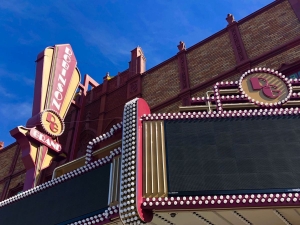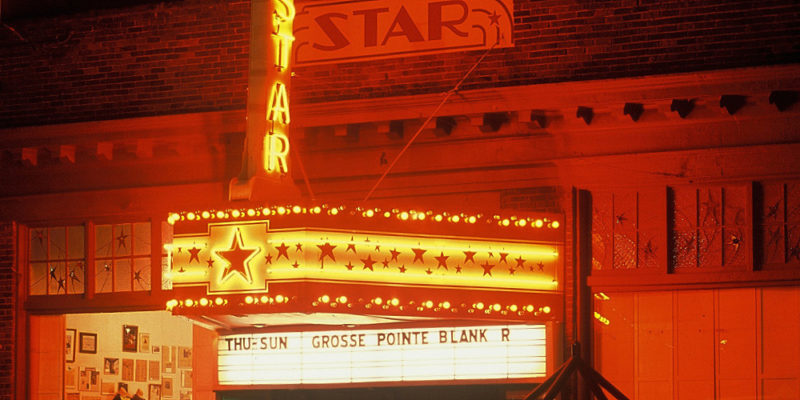ELKINS, W.Va. — Historic movie theaters in West Virginia once played a vital role in isolated sections of the Mountain State, says a historian who's helped breathe new life into these architectural treasures across the region.
Now attracting visitors back to historic downtowns, the restoration of these theaters can be expensive, but financing programs and a new theater-trail project are easing those burdens, says Kelli Shapiro, Ph.D., author of the book "Historic Movie Theatres of West Virginia."
Why historic movie theaters in West Virginia were vital

Especially in the state's mountainous south, geographic isolation made small community theaters more valuable to residents than would typically be the case elsewhere.
"With these towns being so cut off from centers of population, in terms of both distance and difficult terrain, the theaters were, arguably, the primary conveyors of mass culture to the locals, at least in the era before television," Shapiro said.
"They provided a crucial cultural link to the rest of America, presumably making the residents feel somewhat less isolated and part of a broader American culture."
Coal Town Movie Theaters: A Unique West Virginia Story
She said that in southern West Virginia's mountainous coal-mining regions, historic movie theaters in West Virginia were even more distinctive.
"One fairly unique aspect there was the presence of movie theaters built and, generally, operated by coal companies as part of their amenities for the miners and the miners' families in their company towns and coal camps.
"Their existence made life in coal towns more appealing, especially in isolated areas where reaching a town with another theater was neither easy nor fast. Examples of photographs and historical information in the book include those in Affinity, Caretta, and Glen Rogers.
Unique to the southern coal camps, movie theaters were not necessarily recognizable to passersby, Shapiro said.
"Also unique, coal-town theaters were part of multipurpose facilities, not individual structures in downtowns, as is typically the case. They might share a larger building with the company town's soda fountain, billiard hall, dance hall, or barber shop.
"They often didn't even have separate entrances from the street, meaning that the typical markers people recognize today—marquees, ticket booths, poster cases—weren't present or at least weren't visible to passersby. Examples in the book include those in Scarbro, Stirrat, and Widen, among others."
African-American architect designed West Virginia theaters
She said that an African-American architect designed several historic theaters in West Virginia.
"Something else distinctive about historic movie theaters in West Virginia was that several of them were designed by an African-American architect, which was rare nationally during the era of segregation.
"John C. Norman, whose papers are now part of the state archives, designed at least three theaters that we feature in the book. He also designed numerous other buildings across the state. One of them, the Art Deco Shanklin's Grand, in Ronceverte, is still standing, though vacant with a collapsed roof. Ironically, at the time Norman designed it, it was segregated."
How historic theaters drive downtown revitalization
Increasingly across West Virginia and much of the U.S., historic theaters are playing a vital role in attracting visitors to formerly busy downtown commercial districts, Shapiro says—not necessarily as movie theaters but as performance spaces.
"From a revitalization standpoint, events in these theaters help attract residents and visitors to historic downtowns, where they not only attend those events but may also benefit the local economy further by eating and shopping there.
"Theaters help make and keep downtowns vibrant. Their presence can even help bring new businesses to the area. They also provide valuable community-engagement opportunities for local youth and adults, offering things such as acting and dance classes and a multitude of performance opportunities. Theaters get people involved and help them stay active."
Funding options for West Virginia theater restoration
Adapting an old theater is not necessarily an easy task, though Shapiro says financing is often available to offset the expense when theaters are listed on the National Register of Historic Places.
"Funding is often an issue for those hoping to reopen a closed theater or to further rehabilitate an open theater, but excellent options exist to help—including state and federal tax credits, grants through the State Historic Preservation Office, and the new revolving loan-guarantee fund through the Preservation Alliance," she said.
Visit the West Virginia Historic Theatre Trail
Marketing theaters can also be a problem, though the alliance's "West Virginia Historic Theatre Trail" is helping to provide a solution by promoting historic theaters as destinations for heritage tourism.
For more information on restoring historic movie theaters in West Virginia, visit the theater trails resource page.
Historic movie theaters in West Virginia: new landmarks added
New historic movie theaters have been added to the theater trail! Read here to find more.
Sign up to receive a FREE copy of West Virginia Explorer Magazine in your email weekly. Sign me up!




The theater referenced in Ronceverte was recently demolished.
Hi David, I was surprised, and a bit disappointed, to see that the oldest continuously operating movie theater in the United States was not included in your article; The Robey Theatre (Spencer, WV), currently owned by Aaron and Melissa Richardson. It was listed on the National Register of Historic Places on March 29, 1989. Doesn't Robey Theatre deserve a shout-out?!